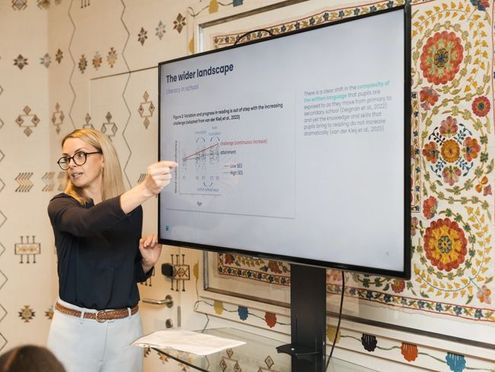This means that on Mapper, learners gain (and keep!) new knowledge of Tier 2 and 3 subject-specific vocabulary alongside their subject content knowledge. Mapper ensures learners communicate like subject experts
However, ensuring this new knowledge is put into practice in the classroom involves linking the learning on Mapper to your in-person teaching.
In this blog, discover some of the ways Bedrock Mapper’s learning sequence and algorithm supports teachers to bring their students’ learning into the classroom, as well as tips and strategies you can use to implement your whole-school literacy strategy deeply and widely.
Implementing Bedrock Mapper
Using Mapper differs from subject to subject, depending on the unique requirements of your discipline and your learners. Due to this, Bedrock Mapper is flexible. There are lots of ways that Mapper can be used by learners to support your teaching and learning and ensure that every student in your classroom can confidently access the curriculum.
Pre-teaching vocabulary
Pre-teaching vocabulary unlocks new texts and information by teaching subject-specific vocabulary before learners have encountered it. This means that learners are prepared for the texts they come across as they move through the curriculum, improving their reading comprehension and overall retention. When these words are encountered organically in texts, these encounters become high-quality exposures rather than a barrier to comprehension.
In order to pre-teach vocabulary, teachers may read ahead in the reading material set - such as case studies in Geography or exam questions in Maths - and identify the Tier 2 and Tier 3 language learners need explicit instruction for, and then provide it through a variety of pre-teaching strategies in the classroom. However, this puts the onus on teachers to identify the words learners will struggle with; it can be challenging to decipher which words a learner may not understand.
E.D. Hirsch: “To grasp the words on a page we have to know a lot of information that isn’t set down on a page.”
As well as this, when explicitly taught important vocabulary, not every learner will have the same initial level of mastery - teachers do not have the time to differentiate explicit vocabulary instruction for every learner in their classroom without help from digital literacy tools.
On Bedrock Mapper, rather than scouring textbooks for high-level vocabulary, teachers can add whole subjects into learners’ lesson plans at the touch of a button. When learners do come to the lessons after completing their Mapper work, they have the prior knowledge of the Tier 2 and 3 vocabulary they need to access their lessons, increasing their comprehension. Over time, this boosts learners’ confidence in their reading, writing and oral communication skills.
Formative assessment
How can teachers ensure all learners know, understand and remember the subject-specific vocabulary of each curriculum area? In a class of 20 to 30, or even more, understanding each individual’s confidence level is a time-consuming process that can feel insurmountable. How can teachers be sure that learners are equipped with the vocabulary they need for the exam hall, and for wider life?
Mapper’s curriculum sequencing allows teachers to map their curriculum so that it works alongside teaching in the classroom. When learners encounter words on Mapper that have been taught in-lesson, teachers can use Mapper to assess understanding as a plenary activity or homework.
Mapper’s self-marking vocabulary curriculum gives teachers powerful insight data. When learners complete work on Mapper, their progress is tracked over time, giving a pre-test and post-test score for each word. This allows teachers to access data that visualises the understanding, retention and mastery of new vocabulary. As well as this, school leaders can use this data to visualise the impact of disciplinary literacy strategies across their school.
Building on the Mapper curriculum in the classroom
Linking Mapper content to classroom activities
On Bedrock Mapper, teachers can map their unique curriculum in a combination of three different ways. They can:
- Use Bedrock Created Content
- Personalise existing community content, or
- Add their own content to the platform.
The control teachers have ensures that learners receive the highest quality curriculum content that is cohesive with classroom learning. For example, teachers can personalise content from the Bedrock Created Content area to add resources used in classroom lessons - geographical images from a school trip as part of the image quiz, or historical documents studied in class as a given example.
Linking classroom resources, such as case studies, documents and quotes, to subject-specific vocabulary on Bedrock Mapper helps to link the learning students complete in class and at home, encouraging seamless, consistent vocabulary improvement. As well as this, linking these resources dual-codes the learning students complete on Mapper, increasing retention and boosting confidence in reading, writing and oral communication.
Harnessing the potential of the written activity
Disciplinary literacy strategies encourage students to think, read and write like experts in any given subject. Not only does Bedrock Mapper equip learners with the knowledge to achieve this across the curriculum, but the extended written activities provide opportunity for learners to write like experts using their new vocabulary. This encourages learners to think deeply about the vocabulary they learn - the subject-specific vocabulary of a particular discipline is not just a tool for the exam hall, but a key that unlocks a student’s ability to think like an expert both within school and beyond.
Reflecting on Mapper work in the classroom
Scaffolding using written activities
The written activities learners complete on Mapper are great examples to use when demonstrating strong writing, modelling an editing process, comparing vocabulary use in a sentence, etc. As well as this, they form a resource bank for learners to use when reflecting on their own work. Not only does this provide another high-quality encounter with new Tier 2 and 3 vocabulary, but learners practise proofreading and editing their work in preparation for the exam hall. No matter the discipline, learners are expected to write at length about subject material, and Mapper’s written activities are a fantastic opportunity to reflect on this as a class, identify misconceptions and improve learners’ writing skills.
A great time to reflect on written work from Mapper would be during a ‘Do Now’ activity. ‘Do Now’ is a strategy from Teach Like a Champion where every lesson is started with a simple activity. Not only is the start of each lesson consistent every day, but reflecting on written tasks becomes an expectation, encouraging students to complete their Mapper work without much effort from you. Learners’ vocabulary and content knowledge is activated at the start of every lesson, keeping learning through literacy at the forefront of students’ minds.
Written work completed on Mapper can be found in the knowledge organiser report; this report is downloadable, allowing for easy transfer into your lesson planning.
Using Mapper’s vocabulary insights report
Just as Mapper’s pre-test reporting gives teachers an idea of learners’ prior knowledge of vocabulary before they begin the lesson, activities learners complete after a classroom lesson help teachers identify misconceptions. Teachers across the curriculum can use the vocabulary insights report to inform the vocabulary they recap.
This approach is especially important when it comes to addressing the vocabulary gap, as learners from disadvantaged backgrounds are more likely to struggle and fall behind when encountering new vocabulary. The vocabulary insights report gives teachers visibility of which learners need additional support, ensuring every learner has the opportunity to thrive.
Whenever teachers at your school use the reporting on Mapper to influence their lesson plans, they link learning on Mapper to teaching in the classroom, creating a unified approach to disciplinary literacy.




